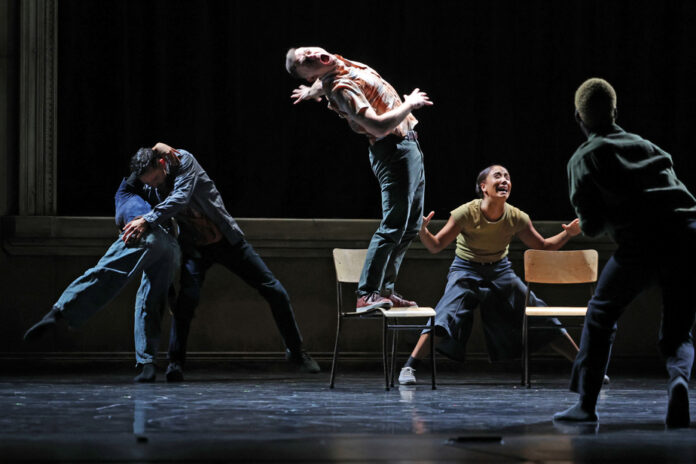Crystal Pite and her company Kidd Pivot are back with her unique approach to dance theater, to say the least, a creative cycle that began a few years ago in collaboration with playwright Jonathon Young. Presented by Danse Danse, Assembly Hall is undoubtedly its most accomplished proposal in this sense, a cleverly structured mise en abîme with visually breathtaking paintings.
Crystal Pite has this talent for creating impactful scenographies, well-finished moving paintings with a certain visual impact. There is no doubt that the Canadian choreographer with international influence – The Guardian named her “dance genius of the 21st century”, no less – has a fine mastery of her art, which she now puts at the service of a dance- surprising, even disturbing, theater when you encounter it for the first time.
Started with Betroffenheit, then refined with Revisor, this approach gives an electric shock to a genre that we thought was over. It is neither pantomime nor a narrative ballet. It is the use of voice and speech (pre-recorded, then “mimed” by the dancers) as an instrument initiating rhythm and movement, which gives rise to moments that are sometimes comical, even burlesque, but also disturbing, dreamlike. . It is the construction of a story in order to then better deconstruct it and propel it to the other side of the mirror, where the veil is lifted on what is teeming behind the surface of things.
There’s always a bit of politics and a fascination with history at Crystal Pite. In Revisor, she explored the issue of corruption, drawing inspiration from a scathing farce written by the Russian author Nicolas Gogol. Assembly Hall immerses us in a medieval universe. First, nothing too bad: a group, enthusiasts of medieval reconstruction, meets in a community hall for its annual meeting. Every year, they organize an event, Quest Fest, but its survival is threatened. Will they vote for the dissolution of the assembly? Some want it, others are fiercely opposed to it.
As the action progresses, the contours of reality blur. Are we witnessing a re-enactment or are we suddenly drawn into a tragic fable, where a beauty grieving over the death of her love, a knight errant and a lost assembly meet? Who needs to be saved, and how?
The scenography is clever. A recreation of a community room, a basketball hoop, two doors topped with the EXIT sign, and a stage with a drawn red curtain. It is on this second stage that the medieval reenactment “scenes” first take place. But as the mise en abyme takes place, the border between the two universes fades. Language is deconstructed, repeated in a loop, distorted, and scenes are replayed, in a whole new light, revealing the forces lurking in the shadows, behind what was apparently banal.
Is Dave, now a knight-errant whose armor builds from scene to scene, possessed or is he playing a game? Does this foam sword actually pierce sides? Crystal Pite plays with codes and transports us into an absolutely fascinating mirror maze.
It is undoubtedly not everyone who will adhere to this sometimes cerebral proposition, despite its very worked, even polished aesthetic. But we can’t blame Crystal Pite for walking down the beaten path.















